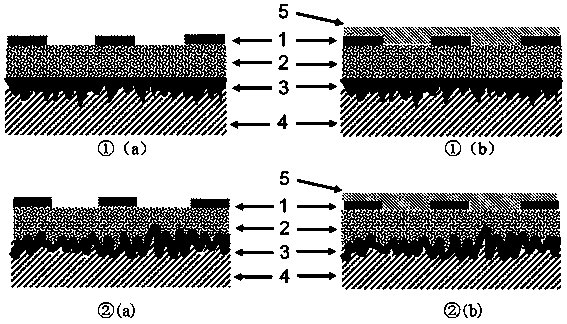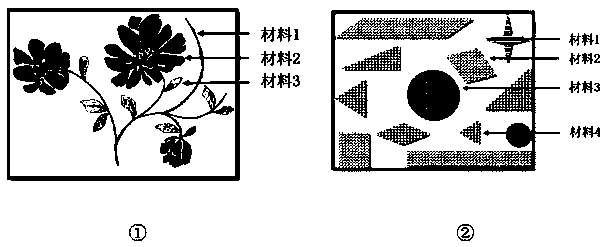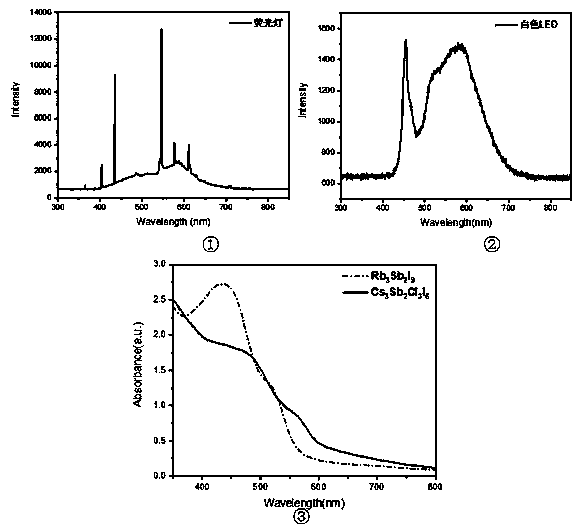Indoor building material with lead-free perovskite photoelectric conversion coating
A building material and photoelectric conversion technology, applied in construction, photovoltaic power generation, building construction, etc., can solve the problems of not being suitable for the pursuit of the overall design of the interior space, not having energy-saving effects, and being difficult to promote on a large scale, and achieving production costs Low, beautify the indoor environment, high photoelectric conversion efficiency effect
- Summary
- Abstract
- Description
- Claims
- Application Information
AI Technical Summary
Problems solved by technology
Method used
Image
Examples
Embodiment 1
[0020] An interior building material with a lead-free perovskite photoelectric conversion coating, such as figure 1 As shown in ①, 1 is a transparent electrode; 2 is a lead-free perovskite material; 3 is a transparent conductive coating; 4 is an ordinary polished tile; 5 is a surface hardening layer. Firstly, a thicker conductive film is coated on ordinary polished tiles, and then a layer of single or multiple combinations of lead-free perovskite materials is coated on the conductive film in a specific pattern, followed by an overall low-temperature annealing treatment, and finally in the absence of A transparent electrode is deposited on the lead perovskite material. Wherein, the thicker conductive film 3 means that its thickness should be enough to smooth the rough substrate surface. According to different application scenarios, the transparent electrode 1 can be replaced by a transparent conductive coating 3 . Such as figure 1 As shown in ①(b), the final product can be s...
Embodiment 2
[0023] An interior building material with a lead-free perovskite photoelectric conversion coating, such as figure 2 As shown, these are two of the specific application forms of color patterned lead-free perovskite materials. Material 1 in the picture is light yellow MA 3 Sb 2 I 9 , material 2 is red Rb 3 Sb 2 I 9 , material 3 is brown Cs 3 Sb 2 Cl 3 I 6 ,, material 4 is yellow Cs 3 Sb 2 I 9 . In this way, lead-free perovskite materials of different colors can be combined to design architectural materials with beautiful patterns, which can recycle indoor artificial light sources and beautify the indoor environment.
Embodiment 3
[0025] An interior building material with a lead-free perovskite photoelectric conversion coating, such as image 3 As shown, two lead-free perovskite materials (Rb 3 Sb 2 I 9 and Cs 3 Sb 2 Cl 3 I 6)'s absorption spectrum is in good agreement with the spectrum of indoor white LED light sources and fluorescent lamps. After testing, the light absorption efficiency of the two materials under the white LED light source can reach 55% and 64% respectively; under the fluorescent light source, the light absorption efficiency can reach 69% and 76% respectively.
[0026] The calculation formula is: (1)
[0027] Among them, S(λ)=energy spectrum of light source; A(λ)=absorbance; λ max = minimum excitation wavelength; λ min = maximum excitation wavelength.
[0028] for Rb 3 Sb 2 I 9 , the light absorption under white LED is 55.53%; the light absorption under fluorescent light is 69.46%.
[0029] for Cs 3 Sb 2 Cl 3 I 6 , the light absorption under white LED is 64.92%; th...
PUM
 Login to View More
Login to View More Abstract
Description
Claims
Application Information
 Login to View More
Login to View More - R&D
- Intellectual Property
- Life Sciences
- Materials
- Tech Scout
- Unparalleled Data Quality
- Higher Quality Content
- 60% Fewer Hallucinations
Browse by: Latest US Patents, China's latest patents, Technical Efficacy Thesaurus, Application Domain, Technology Topic, Popular Technical Reports.
© 2025 PatSnap. All rights reserved.Legal|Privacy policy|Modern Slavery Act Transparency Statement|Sitemap|About US| Contact US: help@patsnap.com



